#daily monitor covid 19
Text
The Weather
In the US, 41 out of 54 states and territories are at high or very high COVID wastewater levels as of 1/18/2024. Ten states and territories have no data available. It’s important to note that levels of “moderate,” “low,” or “minimal” do not necessarily indicate a low risk of COVID exposure in our daily lives. Viral spread is still ongoing even if at lower levels, and precautions are warranted to protect ourselves and others.

Looking at the CDC’s national and regional wastewater data over time, we continue to see “Very High” levels nationally. It’s important to note that the last two weeks are provisional data, indicated by a gray shaded area on the graph, meaning that those values can change as additional wastewater sites report data.
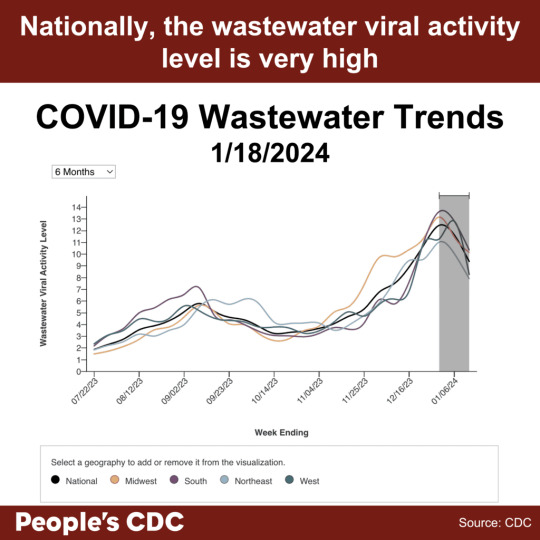
Although wastewater data does not provide the same level of detail as previous PCR-based testing data, wastewater monitoring is an important ongoing resource to inform us about the current COVID situation. While the provisional data tentatively shows a downward trend this week, time will tell whether this is a true decrease in the final data. A downward trend does not mean continued decreases are guaranteed or that protections should be relaxed. Multilayered protections help drive COVID spread lower, and relaxing protections can lead to a resurgence of viral spread.
Visit the CDC’s State and Territory Trends page to see available wastewater testing near you, including the number of wastewater sites reporting. Write your elected officials to let them know you want to keep and expand wastewater testing in your area and nationally.
Wins
In November 2023, the CDC’s Healthcare Infection Control Practices Advisory Committee (HICPAC) passed a series of draft proposals that will further weaken already insufficient protocols employed within healthcare settings. HICPAC refuses to reckon with the airborne nature of infectious diseases such as SARS-CoV-2, and does not propose crucial measures such as universal masking with well-fitted respirators, isolation periods, and ventilation. The People’s CDC has penned a letter to the ACLU alerting them of HICPAC’s irresponsible decisions, and the ramifications associated with them. We hope that by working together with the ACLU, we can implement public advocacy and legal actions in order to tackle this critical issue.
You can read the full letter here.
Johns Hopkins reinstated healthcare masking on 1/12/2024, in response to high respiratory virus levels. As with many other healthcare systems and public health departments that have restored healthcare masking when facing public pressure, we hope that universal masking can become a standard of care rather than a short term response to a surge. See “Take Action” below for more information.
Variants
JN.1, now the most prominent variant in the United States, is estimated to account for 85.7% of circulating variants by 1/20/2024. HV.1 is expected to drop to 5.3%, and all other variants are estimated to make up less than 2% each. Although ongoing viral spread allows opportunities for new variants to emerge, the latest 2023-2024 COVID vaccine boosters, COVID tests, and COVID treatments are still expected to be effective for JN.1.
Current updated booster uptake is low (as of January 19, 2024, the CDC reports that only 21.5% of adults and 11% of children have received it). It is not too late to get the updated booster, and to protect yourself against the latest variant!
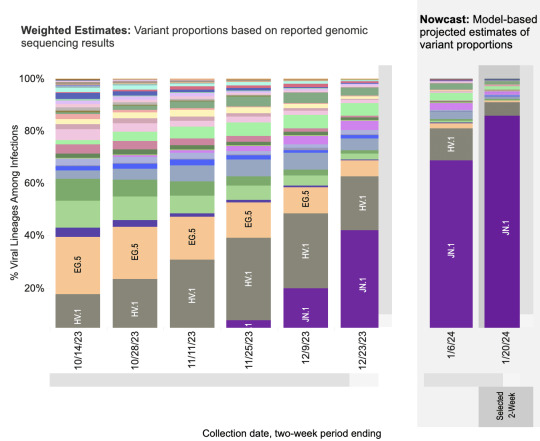
Hospitalizations
In the most recent week (ending January 13, 2024), we see a slight downward trend in new hospital admissions, currently at 32,861. We see a similar slight downtick in currently hospitalized patients with COVID , at 27,879. This most recent week shows a slight decrease in hospitalizations, although it is too soon to say whether hospitalizations for the current surge have passed their peak. Hospitals continue to be overwhelmed. The data also lacks information on hospital-acquired infections. We urge you to continue taking stringent precautions, such as donning a well-fitting respirator (e.g., N95, KN95) in all indoor spaces–and especially in healthcare settings.

Long COVID
Amid ongoing advocacy by Long COVID groups, the US Senate Committee on Health, Education, Labor, and Pensions (HELP) held a committee hearing on “Addressing Long COVID: Advancing Research and Improving Patient Care.” The hearing included testimony from three Long COVID patients and four Long COVID physicians and researchers, bringing much-needed attention to the urgent need for funding for Long COVID research and treatments, and to the need for improved access to care for Long COVID patients. We recognize the community care modeled by some of the panelists and attendees who wore masks for the hearing, and we wish the senators on the committee would mask up as well.
Take Action
Write your elected officials to let them know that Long COVID impacts all of us, and that we need ongoing support for Long COVID research and clinical care. Ask Senators to support bill S.2560, the Long COVID Support Act. Ask Representatives to support bills HR.1114 (Long COVID RECOVERY NOW Act) and HR.3258 (TREAT Long COVID Act).
Although some healthcare settings have reinstated masking in response to high COVID levels along with high respiratory virus activity, ongoing pressure is needed to restore, keep, and expand masking broadly. Use our letter template and toolkit to call or write your elected officials in support of healthcare masking.
Want to do more to support healthcare masking? Consider starting, sharing, or joining a local campaign. Check out work in Illinois, Maryland, and Wisconsin, just to name a few. Also, sign and share our letter to the ACLU asking them to join us in supporting safe and equitable access to healthcare. Sign on is open until 2/1/2024.
#op#covid#covid pandemic#covid news#covid 19#covid-19#covid isn't over#covid19#mask up#coronavirus#pandemic#people's cdc#pcdc#long covid#sars cov 2#sars-cov-2#coronavirus pandemic#wear a mask#covid variant#covid variants#covid vaccine#get vaccinated#covid vaccines#medical#disability#uspol#img#links#to read#described in alt text
184 notes
·
View notes
Text
Just a "mild" neuron infection you got from brunch with the girlies :)
Highlights
"Our study shows that the increase in serum biomarkers of neuronal and glial damage, sNfL and sGFAP, was present one week after resolution of asymptomatic SARS-CoV-2 infection or mild COVID-19 and was more pronounced in patients with cognitive impairment. Furthermore, 10 months after resolution of the infection, levels of these biomarkers were still significantly higher than in healthy controls, although reduced from those observed at baseline. At the same time, self-reported cognitive impairment appeared to worsen in the same subjects, suggesting that early neuronal and glial damage may have resolved by 10 months post-infection, although subjective cognitive impairment may persist or become more pronounced."
"The second relevant finding of our study is represented by the higher sNfL and sGFAP levels in the eleven COVID-19 patients complaining of cognitive failures at T0. Cognitive deficits are common after COVID-19 and can impair executive functions, attention, and episodic memory. Studies on the neuropsychological alterations during acute COVID-19 and in the post-COVID-19 phase show inhomogeneous results, particularly for the variable time of the evaluation, ranging from two to five weeks after the onset, up to one year after the recovery. Most of these studies, however, mainly focus on hospitalized patients, being non-hospitalised patients somehow overlooked."
"A recent study showed that more than one-third of hospitalized and non-hospitalized patients after COVID-19 experienced a perceived cognitive deficit after 30 days after hospitalization or outpatient infection. It should be noticed that, differently from our population, this patient cohort included mainly hospitalized patients with remarkable comorbidities. Our study shows cognitive failure immediately following the recovery in a not negligible percentage (7.5%) of COVID-19 patients, suggesting a clinical impact of SARS-CoV-2 even in individuals with the mildest forms of the disease."
"The previous literature on mild or non-severe COVID-19 cases clearly indicates their significant impact on cognitive function, particularly in domains such as working memory and processing speed, with a good potential for recovery over time though some impairments may persist. Cognitive failures, therefore, may interfere with highly complex working activities, particularly those that require attending to and remembering large amounts of information, like academic or administrative jobs."
"Our patients with CFQ scores higher than 43 could experience high difficulties when returning to their work. The negative impact on daily functioning and quality of life of post-COVID cognitive dysfunction has been highlighted by Quan et al. emphasizing the economic, health, and social burden associated with. In fact, Beck and Flow demonstrate that individuals who had contracted SARS-CoV-2 infection reported cognitive failures at work and difficulty performing their tasks, highly detrimental to their performance, and may leave a job looking for other sources of employment."
"This evidence provides support for the need to perform careful neuropsychological evaluations for all the workers following SARS-CoV-2 infection, to allow both an adequate resumption of work activities and to monitor the onset of any cognitive impairment even in workers with a previous mild COVID-19 or asymptomatic infection."
#mask up#covid#covid 19#covid isn't over#pandemic#covid conscious#long covid#covid is airborne#wear a mask#coronavirus
13 notes
·
View notes
Text
Lula government ends daily COVID-19 tracking in Brazil
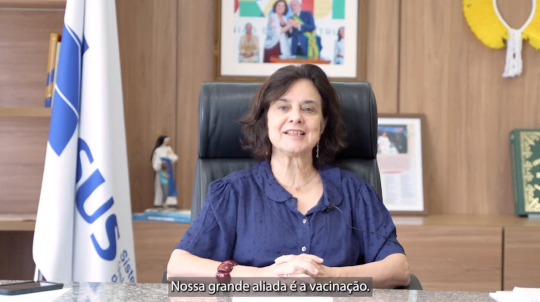
Facing the clear threat of a worsening pandemic in Brazil, driven by the Omicron XBB.1.5 subvariant, the Workers Party (PT) government of President Luiz Inácio Lula da Silva has signaled its intention to declare the pandemic over and get the Brazilian population used to “living” with the coronavirus.
On February 16, the Health Ministry announced that it will start releasing COVID-19 data of cases, deaths and vaccination rates weekly and no longer daily, starting March 3. Trying to justify what in practice means a further departure from monitoring the pandemic in the country, the Health Ministry’s director of immunization, Eder Gatti, stated that only nine of the 27 Brazilian states update the data daily, which supposedly does not “allow an epidemiological analysis.” Still, he claimed,“We are not restricting data. ... What we want here is to facilitate the work with the data and send weekly data that is more accurate.”
This claim is patently false. If the Lula government had a genuine concern about the pandemic, the least it could do is coordinate a national effort and assist the states in implementing a system to monitor the pandemic on a daily basis, with a mass testing program, genetic sequencing of the variants in circulation, among other measures completely ignored by the “herd immunity” policy of the former fascistic President Jair Bolsonaro.
However, almost two months after taking office, the Lula government has not reversed the Bolsonaro government’s measures to prioritize corporate interests over human lives, including its ending of the National Public Health Emergency due to COVID-19 as early as April 2022. The Lula government has also failed to implement awareness campaigns about the airborne transmission of SARS-CoV-2, the importance of wearing quality masks and distributing them for free, as well as other basic public health measures that would have an almost immediate impact and could prevent cases and deaths.
Continue reading.
#brazil#politics#brazilian politics#coronavirus#covid 19#nisia trindade#mod nise da silveira#image description in alt
37 notes
·
View notes
Text
Please be aware, data not being collected does not mean there is no data. Reach out to your local representatives to push HARD for continued funding of waste water monitoring. It is the most reliable, and an incredibly vital resource. Without information about viral trends, it becomes quite uncertain how to proceed for the average person and for communities.
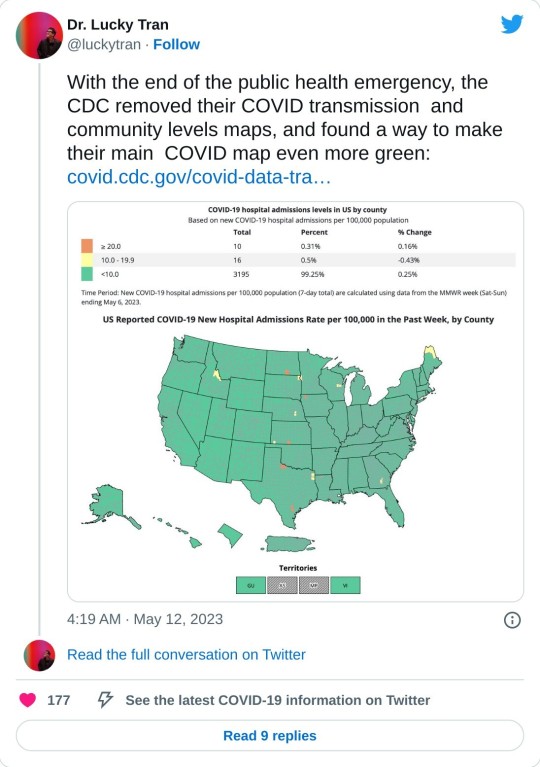
I posted an article awhile back about waste water monitoring finding quite potentially being in a precarious position. Furthermore this would lead to outbreaks and the general public being unawares and run afoul of horrible outcomes.
The work of aggregating and collating of data is being left to individuals, which is not only horrifying, unethical and well out of step with science based methods and guidance, but highly unusual given data is kept and provided for other illnesses, especially ones as severe and concerning as covid-19 (SARs CoV 2).
For the time being, I personally will be assuming transmission is moderate to high in addition to my sources. In the absence or great reduction of data and reports, greater estimations and assessment of made, and when only observations, assumed. Be as safe as you can everyone 💝 - Admin
Please be aware of what may no longer be offered, operating or an out of pocket cost. Masks, tests (all types), vaccines, remote options, COVID-19 tracking apps. Also be mindful of any local or nationwide level policies, proposals, news or trends that cite mask and other NPI removals, bans, stigma or efforts towards criminalization.
For the time being, the following resources remains invaluable:

https://biobot.io
It has come to my attention the person whose account is Laughter In Light has falsely claimed a prominent disability advocate encouraged or engaged in doxxing and slander with no demonstrable proof which has led to great harm. Laughter in light has provided some very helpful information throughout the pandemic. It is also important to be aware, critical and hold people into account for their actions, ideologies, commentary/statements and or stances. There are many other wonderful sources to inform oneself and stay up to date. - Admin
Provides regular updates on infectious diseases news

Sadly they don't have a website or any links I know of. Their Twitter is public however and can be viewed even without an account.

Give incredible analysis and updates on SARS CoV-2! Excellent medical and scientific communicator!

Stella has been amazing since the beginning and continues to be. Definitely worth following! Check out their link tree! They're also on Tiktok!
If anyone has any international resources for updates and tracking, please add it via reblog and I'll definitely share! - Admin
#covid-19#covid 19#sars cov 2#covid#Data tracking#Reports#Waste Water Monitoring#Cases#Deaths#Excess Deaths#Long covid#long haul covid#the pandemic#pandemic#public health#Lucky#Lucky Tran#Peoples CDC#Biobot Analytics#Laughter in Light#Tiffany Najberg#Walgreens Covid-19 Index#Waste Water Scan Dashboard#Our World In Data
20 notes
·
View notes
Text
Australia News: 24.3.24.
1.) "The Australian dream of owning your own home - Albanese style. Coming to a city near you."

2.) "Media Shame File: Journalists show their economic illiteracy daily when it comes to immigration, but even so it's worrying that the political editor of The Age doesn't seem to understand how unemployment can fall during record-high population growth."
I'd say they were fully aware of what they were doing.

3.) QLD HOMESCHOOLING CRACKDOWN ->
https://youtu.be/TudVFaYc36A
Make a submission: https://qldparlcomm.snapforms.com.au/form/eetsc---education-general-provisions-and-other-legislation-amendment-bill-2024.
It is highly likely that other governments will enact similar harsh laws if they succeed in Queensland. Do not let them.
Also
"Our main points of concern:
we do not want to be restricted to using the Australian Curriculum.
reporting to EVERY area in the plan and PROVING educational progress is too much and not even required in schools.
determining if home education is in the best interest of the child is a parental right, this power doesn't belong with the Education department."
Parents should have the freedom to decide how best to educate their children because education is not a one-size-fits-all solution.
4.) NDIS - What is myplace?
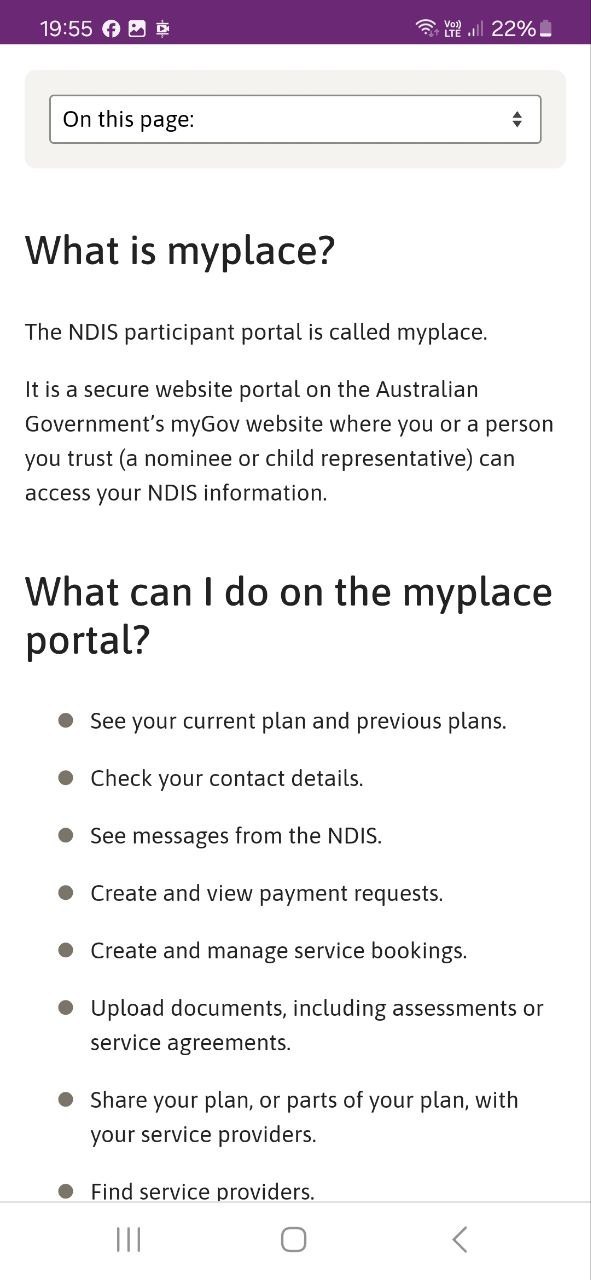

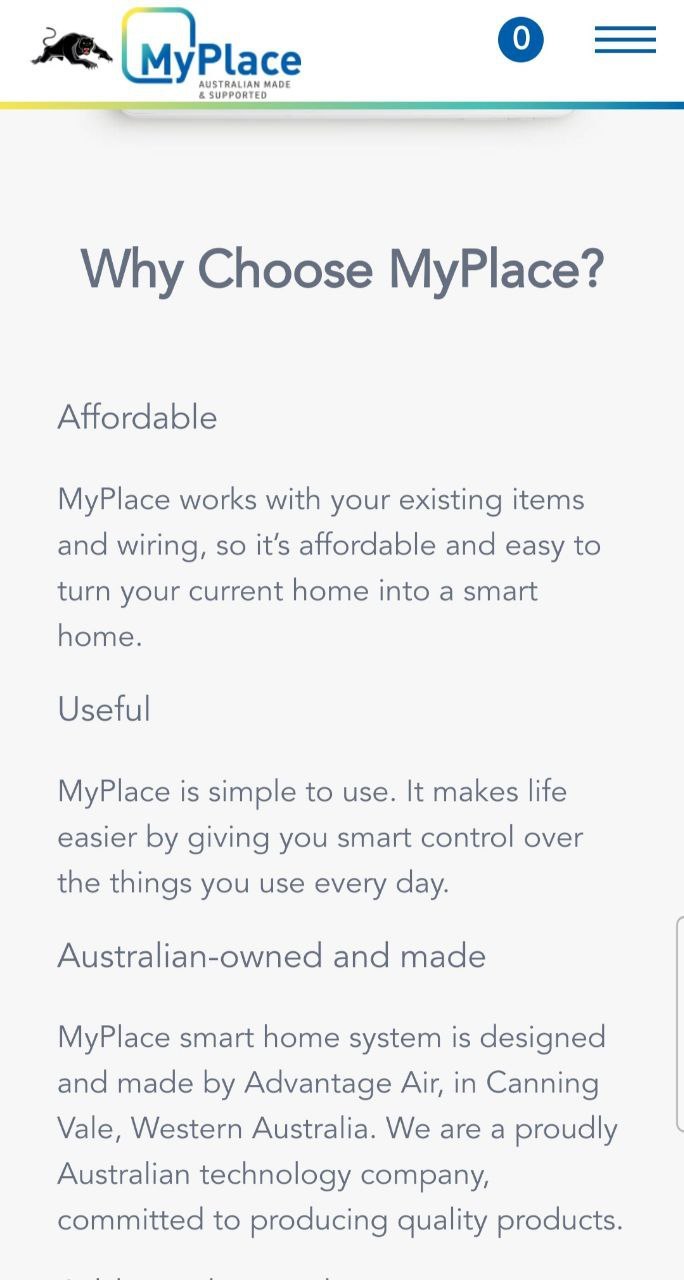
"Just a heads up for all you MyPlace people. There are already trade marked companies in Australia using that name.
Be warned you may be in danger of copyright infringement and court action.
I'm telling you this because I care that you don't get sued, and also because you really should not use someone else's business name. Be original rather than just copying someone else.
The MyPlace brand in Australia is to do with Government, Monitoring, Professional Sports Sponsorship, Public Education and The NDIS. Do you really want your name involved with that?
I wouldn't.
@roobsaussieflyers."
5.) Australia Immigration ->

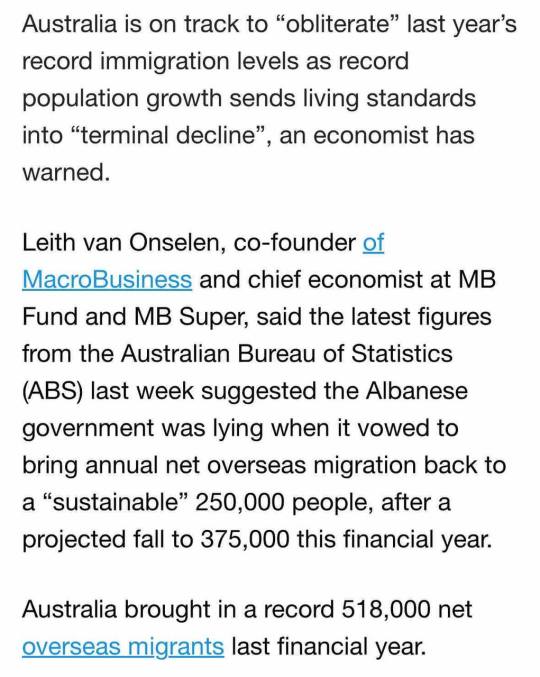
"Record immigration is causing a housing crisis that’s now a human catastrophe
The more serious governance issue is Labor federal government lying last year saying it would reduce immigration
One Nation exposed the Lib-Lab Uniparty “big Australia”
People want immigration cuts." - Senator Roberts uncensored - Telegram.
6.) "Getting a COVID jab is safer than taking aspirin."

"Currently appears on the University of Melbourne website.
“The risk of rare side effects from COVID-19 vaccines like AstraZeneca are greatly exaggerated as they are far safer than many medicines people are taking every day.” "
- @PeoplePowerAus.
2 notes
·
View notes
Text
Is Social Media Useful in Spreading Information on COVID-19 in Malaysia?

In the current digital era, social media has become an integral part of our lives, connecting us to our family, friends, and the world. In addition to sharing photos, social media has played a significant role in disseminating information about crucial issues, particularly during the COVID-19 pandemic. Let's explore how social media helps spread virus-related information and its impact on digital communities.
The Power of Social Media for COVID-19 Information
1. Rapid Dissemination of Information
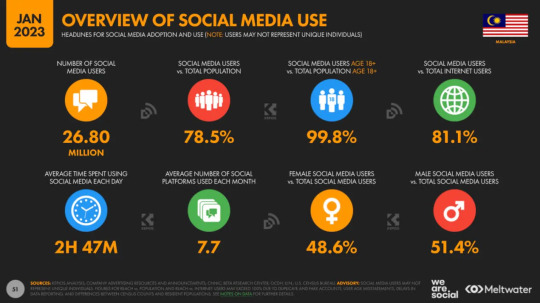

During the early phases of the COVID-19 pandemic, the increased social media activity in Malaysia played a crucial role. Malaysians were well-connected digitally, as they spent an average of 2 hours and 47 minutes daily on social media, surpassing the global average by a significant margin. This participation was primarily motivated by the need to obtain information (76.2%) and keep up with news and events (65.8%). Facebook, Twitter, and WhatsApp were the primary sources for vital updates, news, and recommendations. This ongoing flow of information helps increase the awareness and preparedness of the digital community (Howe, 2023).
2. Real-time Updates
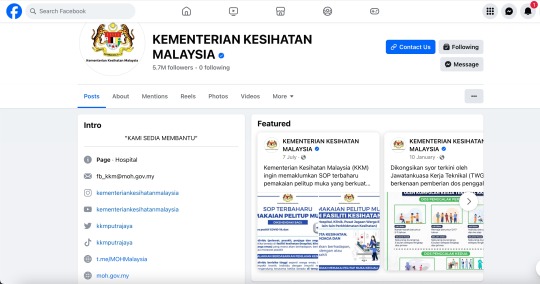

The Malaysian government provided up-to-date COVID-19 information via e-government and social media. They relied on channels such as the Ministry of Health's Official Portal, specialised Facebook pages (such as CRPC and KKM), and the CPRC KKM channel on Telegram. The Director-General of Health's daily press briefings are not only broadcast live on television but also live online via Facebook. In April 2020, they released the MySejahtera mobile app to assist users in monitoring their health and reporting check-in locations, allowing for prompt responses to control the spread of the virus (Dawi et al., 2021).
3. Community Support

During these difficult times, social media has been essential in helping Malaysians feel more connected to one another, with many Facebook groups and online communities offering information and support. For example, neighbours used platforms such as Nextdoor to offer assistance to those in need, and digital communities united in unprecedented ways to share resources and aid one another (FMT Media Sdn Bhd, 2020). Moreover, #benderaputih groups were formed on Facebook to share addresses for assistance and information on local food banks, with Malaysians in need flying white flags outside their residences to indicate distress. The digital community, including neighbours, personalities, and businesses, responded by donating food and other necessities, demonstrating the power of social media to bring communities together in times of crisis (BBC News, 2021).
4. Countering Misinformation

By actively utilizing social media, the Malaysian Ministry of Health (KKM) has taken significant measures to combat COVID-19 misinformation. Through their official social media channels, KKM provides accurate and up-to-date information, dispels misconceptions, and addresses concerns, ensuring that the public receives trustworthy information and is better equipped to make informed decisions during the pandemic. In addition, KKM has released information about the repercussions of disseminating false information. This proactive approach not only helps counter Misinformation but also fosters a sense of trust in official sources, which is crucial during a public health crisis (Euronews, 2020).
The Dark Side of Social Media in COVID-19 Information Spread
1. Misinformation and Rumors

In Malaysia, as in many other countries, social media has served as a breeding ground for Misinformation and rumors about COVID-19. Facebook and WhatsApp have been used to spread false information about the virus's origins, prevention, and treatment options. This has led to public confusion and, in some cases, hazardous behavior, such as disregarding medical advice. False information can undermine the efforts of health authorities and exacerbate the pandemic's effects, causing unnecessary alarm (Balakrishnan et al., 2021).
2. Amplification of Fear

Despite its many advantages, social media can be a double-edged instrument, particularly during a crisis such as the COVID-19 pandemic. One of its negative characteristics is its potential to amplify fear and anxiety. Sensationalized headlines and the dissemination of misleading images can elicit strong emotions, resulting in increased stress and negative effects on mental health. The internet has been rife with misleading information about the virus, including conspiracy theories and misleading statistics. There have been instances where images fraudulently purporting to depict the coronavirus under a microscope have caused panic and confusion. Such false information can be extensively disseminated on social media platforms like Facebook, inciting panic and undermining accurate comprehension (Euronews, 2020).
Conclusion
In conclusion, social media has proven to be a powerful tool in spreading information about COVID-19 in Malaysia. During the pandemic, it rapidly disseminated vital information and connected people, nurturing community and support. The government's use of social media channels contributed to disseminating timely information to the public. However, this has a negative aspect: disseminating false information and terror. Misinformation and sensationalized content have led to public perplexity and hysteria. To maximize the benefits of social media, we must use it responsibly and ensure that accurate information prevails, particularly during the pandemic. Connecting and informing us, social media can be a force for good, but it is up to each of us to ensure that it serves our best interests.
What's your opinion on the role of social media in spreading COVID-19 information in Malaysia? Share your thoughts and vote below.
Reference list
Balakrishnan, V., Ng, K. S., & Rahim, H. A. (2021). To share or not to share – The underlying motives of sharing fake news amidst the COVID-19 pandemic in Malaysia. Technology in Society, 66, 101676. https://doi.org/10.1016/j.techsoc.2021.101676
BBC News. (2021). Malaysians in Covid lockdown fly white flags to ask for help. BBC News. https://www.bbc.com/news/world-asia-57717214
Dawi, N. M., Namazi, H., Hwang, H. J., Ismail, S., Marešová, P., & Krejcar, O. (2021). Attitude toward protective behavior engagement during COVID-19 pandemic in Malaysia: the role of e-government and social media. Frontiers in Public Health, 9. https://doi.org/10.3389/fpubh.2021.609716
Euronews. (2020, January 30). Coronavirus: Malaysia arrests five for spreading misinformation online | #TheCube. Euronews. https://www.euronews.com/my-europe/2020/01/29/coronavirus-malaysia-arrests-five-for-spreading-misinformation-online-thecube
FMT Media Sdn Bhd. (2020). Nextdoor: Free network connecting neighbours in quarantine. Freemalaysiatoday. https://www.freemalaysiatoday.com/category/leisure/2020/03/29/nextdoor-free-network-connecting-neighbours-in-quarantine/
Howe, S. (2023). Social Media statistics for Malaysia [Updated 2023]. Meltwater. https://www.meltwater.com/en/blog/social-media-statistics-malaysia
#mda 20009#week 7#social media#covid19 malaysia#public health#digital communities#malaysia#stayinformed
5 notes
·
View notes
Text
On July 19, Bloomberg News reported what many others have been saying for some time: Twitter (now called X) was losing advertisers, in part because of its lax enforcement against hate speech. Quoted heavily in the story was Callum Hood, the head of research at the Center for Countering Digital Hate (CCDH), a nonprofit that tracks hate speech on social platforms, whose work has highlighted several instances in which Twitter has allowed violent, hateful, or misleading content to remain on the platform.
The next day, X announced it was filing a lawsuit against the nonprofit and the European Climate Foundation, for the alleged misuse of Twitter data leading to the loss of advertising revenue. In the lawsuit, X alleges that the data CCDH used in its research was obtained using the login credentials from the European Climate Foundation, which had an account with the third-party social listening tool Brandwatch. Brandwatch has a license to use Twitter’s data through its API. X alleges that the CCDH was not authorized to access the Twitter/X data. The suit also accuses the CCDH of scraping Twitter’s platform without proper authorization, in violation of the company’s terms of service.
X did not respond to WIRED’s request for comment.
“The Center for Countering Digital Hate’s research shows that hate and disinformation is spreading like wildfire on the platform under Musk’s ownership, and this lawsuit is a direct attempt to silence those efforts,” says Imran Ahmed, CEO of the CCDH.
Experts who spoke to WIRED see the legal action as the latest move by social media platforms to shrink access to their data by researchers and civil society organizations that seek to hold them accountable. “We're talking about access not just for researchers or academics, but it could also potentially be extended to advocates and journalists and even policymakers,” says Liz Woolery, digital policy lead at PEN America, a nonprofit that advocates for free expression. “Without that kind of access, it is really difficult for us to engage in the research necessary to better understand the scope and scale of the problem that we face, of how social media is affecting our daily life, and make it better.”
In 2021, Meta blocked researchers at New York University’s Ad Observatory from collecting data about political ads and Covid-19 misinformation. Last year, the company said it would wind down its monitoring tool CrowdTangle, which has been instrumental in allowing researchers and journalists to monitor Facebook. Both Meta and Twitter are suing Bright Data, an Israeli data collection firm, for scraping their sites. (Meta had previously contracted Bright Data to scrape other sites on its behalf.) Musk announced in March that the company would begin charging $42,000 per month for its API, pricing out the vast majority of researchers and academics who have used it to study issues like disinformation and hate speech in more than 17,000 academic studies.
There are reasons that platforms don’t want researchers and advocates poking around and exposing their failings. For years, advocacy organizations have used examples of violative content on social platforms as a way to pressure advertisers to withdraw their support, forcing companies to address problems or change their policies. Without the underlying research into hate speech, disinformation, and other harmful content on social media, these organizations would have little ability to force companies to change. In 2020, advertisers, including Starbucks, Patagonia, and Honda, left Facebook after the Meta platform was found to have a lax approach to moderating misinformation, particularly posts by former US president Donald Trump, costing the company millions.
As soon as Musk took over Twitter in late October 2022, he proceeded to fire many of the staff members responsible for keeping hate speech and misinformation off the platform and reinstated the accounts of users who had been previously banned, including Trump and influencer Andrew Tate, who is currently indicted under human trafficking laws in Romania. A study released earlier this year from the University of Southern California’s Information Sciences Institute, Oregon State University, UCLA, and UC Merced found that hate speech increased dramatically after Musk took the helm at Twitter. Over roughly the same time period, the company saw its advertising revenue slashed in half as brands—including General Motors, Pfizer, and United Airlines—fled the platform, apparently concerned about their products appearing next to misinformation and hate speech.
And this has bothered Musk, immensely. On November 4, 2022, he tweeted, “Twitter has had a massive drop in revenue, due to activist groups pressuring advertisers, even though nothing has changed with content moderation and we did everything we could to appease the activists. Extremely messed up! They’re trying to destroy free speech in America.”
PEN America’s Woolery worries that, whether or not X’s lawsuit against CCDH holds water, the cost of fighting it will be enough to intimidate other organizations doing similar work. “Lawsuits like this, especially when we are talking about a nonprofit, are definitely seen as an attempt to silence critics,” she says. “If a nonprofit or another individual is not in a financial position where they can really, truly give it all it takes to defend themselves, then they run the risk of either having a poor defense or of simply settling and just trying to get out of it to avoid incurring further costs and reputational damage.”
But the lawsuit doesn’t just put pressure on researchers themselves. It also highlights another avenue through which it now may be more difficult for advocates to access data: third-party social listening platforms. These companies access and analyze data from social platforms to allow their clients—from national security contractors to marketing agencies—to gain insights into their audiences and target messages.
Tal-Or Cohen Montemayor, founder and executive director of CyberWell, a nonprofit that tracks anti-Semitism online in both English and Arabic, says that in November 2022, shortly after Musk took ownership of the company, CyberWell reached out to Talkwalker, a third-party social listening company, to get a subscription that would allow them to analyze anti-Semitic speech on the platform then called Twitter.
Cohen Montemayor says Talkwalker told her the company could not take them on as a client because of the nature of CyberWell’s work. She says it appears that “the existing open source tools and social listening tools are being reserved and paywalled only for advertisers and paid researchers. Nonprofit organizations are actively being blocked from using these resources.”
Talkwalker did not respond to a request for comment about whether its agreements with X prohibit it from taking on organizations doing hate speech monitoring as clients. X did not respond to questions about what parameters it sets for the kinds of customers that third-party social listening companies can take on.
According to X’s lawsuit against CCDH, a 2023 agreement between Brandwatch and X outlined that any breach of X data via Brandwatch’s customers would be considered the responsibility of the social listening company. On X competitor Bluesky, Yoel Roth, the former senior director of trust and safety at Twitter, posted, “Brandwatch’s social listening business is entirely, completely, 100% dependent on Twitter data access, so I guess it’s not surprising to see how far backwards they’re bending to placate the company.”
For its part, in a July 20 tweet, Brandwatch referenced the same CCDH report cited in the X lawsuit, saying, “Recently, we were cited in an article about brand relevance that relied on incomplete and outdated data. It contained metrics used out of context to make unsubstantiated assertions about Twitter.”
Brandwatch did not respond to a request for comment.
But CCDH’s Ahmed says the assertion that his organization’s research is based on incomplete data is a way for X to obfuscate problems with its own platform. “Whenever you claim that you’ve found information on there, they just say, ‘No, it’s a lie. Only we have the data. You couldn't possibly know the truth. Only we know the truth. And we grade our own homework,’” he says.
A representative from another third-party social listening tool that uses X data, who asked to remain anonymous to protect their company from retaliation by X, confirmed to WIRED that companies like theirs are heavily reliant on Twitter/X data. “A lot of the services that are very Twitter-centric, a lot of them are 100 percent Twitter,” they say, noting that Instagram has long since shut down its API, and that conversations on Meta’s platforms tend not to be as public as those on X. “In terms of data, Twitter continues to play a significant role in providing data to analytics companies.” They note that, while X’s new paid-for API has put the squeeze on third-party analytics companies—“it’s basically almost like they’re holding you for ransom”—losing access to X data entirely could kill a company.
They add that they have not seen guidelines that restrict the use of X data for hate speech or advocacy research, but there are specific “know your customer” guidelines that prohibit sharing X data with government agencies without prior permission. The same day X announced the lawsuit, on July 31, America First Legal, a right-wing nonprofit led by former Trump appointee Stephen Miller, announced that it had filed Freedom of Information Act (FOIA) requests to examine communications between CCDH and various US government agencies, alleging that it is a “coordinator of illegal censorship activities.” (Ahmed says his organization has never coordinated with the US government). This would, if true, seemingly also be a violation of those terms of service.
The X lawsuit also alleges that the CCDH is being funded by X’s competitors as well as “government entities and their affiliates,” but says that “X Corp. currently lacks sufficient information to include the identities of these entities, organizations, and persons in this Complaint.”
Even without legal threats, there are significant costs to researchers focused on disinformation and hate speech on platforms. Experts who spoke to WIRED say they worry the threat of legal action could cause a chilling effect on other organizations that study hate speech and disinformation.
After publishing a report showing that anti-Semitic content had doubled on the platform after Musk’s takeover, Sasha Havlicek, cofounder and CEO of the Institute for Strategic Dialogue (ISD), a London-based think tank focused on extremism and disinformation, says the company experienced a deluge of abusive tweets. “In response, Twitter came out with a thread that got 3 million views or so,” she says. “Musk himself responded with a poop emoji.”
In December, Musk worked with right-wing journalists to release the so-called Twitter Files, a selection of internal documents that seemed to show that pre-Musk Twitter had silenced some conservative users. Some of the documents included the names and emails of disinformation researchers at the Stanford Internet Observatory, many of whom were undergraduate students at the time. One former student, who asked to remain anonymous for fear of harassment, says that people whose emails ended up in the Twitter Files have been targets of ongoing harassment for their role in disinformation research.
“Seeing how things have gone, and seeing the possibility of being harassed, has made a lot of people that worked on it very closely to now think twice,” says the former student.
“You have to ask,” says the ISD’s Havlicek. “Who’s the censor now?”
Havlicek says she hopes that the EU’s Digital Services Act (DSA), which will eventually mandate access for researchers to data from large social platforms, will be a road map for other countries. Whether there will be legal land mines regarding data pulled legally by European researchers under the DSA but shared with non-European researchers or advocates is another open question.
“I was in Brussels a few weeks ago talking to the Digital Services people about how we can use the data that will be made available through the DSA data transparency regime,” says Ahmed. “And when that appears, we will use that in the most effective way possible.”
3 notes
·
View notes
Text
Public Health of today
The days of having commercials of how dangerous smoking is and PSA (Public Service Announcement) such as TakNak, a PSA showing multiple variety of the public rejecting a stick of cigarettes are not necessary long gone but they are not the biggest trend at the moment.
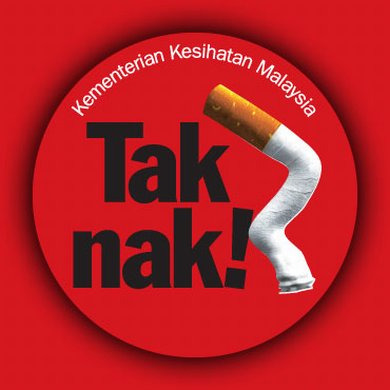
source: http://cikgutancl.blogspot.com/2008/06/remaja-sekarang-tak-nak-atau-mereka.html
As an ex smoker myself, it is safe to say it did not work on me but I vividly remember that I will doubt myself when I wanted to have a puff thinking about all the advertisements and signs everywhere such like the one above. The doubt alone in my opinion makes it successful PSA, just that maybe I was just a little too on edge when I was in my rebel stage in life. 🤡
Today, the way the Ministry of Health Malaysia (MOH) pushes out public health with the most affect would obviously the use of social media such as Twitter and the creation of the hit app, MySejatera.

source: https://www.edgeprop.my/content/1769410/ministry-health-mysejahtera-not-spying-app
The past 2 years, our beloved Director-General of Health of Malaysia, Tan Sri Dato’ Seri Dr Noor Hisham Abdullah, made a huge move of being hyper active on Twitter. He was fact checking questions and replying to them on Twitter on a a daily. Even though he is not as active as back then, I still see him retweeting and liking issues that he thinks that need more attention and he will always have my respect for reaching out to wider audiences knowing not everyone is into traditional media like the new.
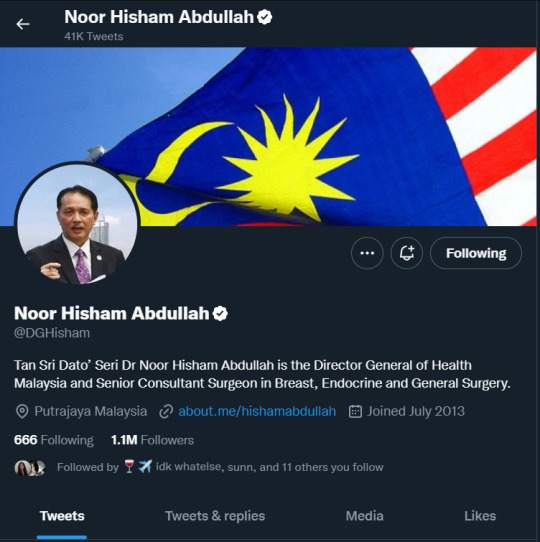

Source: Twitter
On the other hand, the creation of MySejatera was just a brilliant move. I see it as killing two birds with one stone by making it mandatory to have the app to both open a business or even as a consumer so everyone has to download the app. This makes tracking a big amount of the public with ease. Down the road of the pandemic, they started updating the software to help with Q&A about Covid-19 and what I would say killing the third bird, using it as the app to track an individual's vaccine status. The app also helped with setting dates for everyone's vaccine, advice on what to do if one is feeling unwell after the vaccine and gave everyone a digital certificate on top of that.
Nowadays as we approach the endemic and monitoring of the virus is not that big of a deal, the app still keeps the records for the individuals with the additions of other information about other common health issues which is really neat.

I am going to be real, I usually am not very proud of my country but aside of our passion for food and certain sports, I confidently say I am very proud of our health care and their commitment to help advice the public with any health problems without breaking the bank.
Forget about the PSAs about quitting smoking, it may not have bring me to a healthier lifestyle but they sure did make me feel good about what I have in my country right here.
This is Loren's Beautiful Mind, thank you for staying in my dangerous place. Peace ✌
8 notes
·
View notes
Text
Spanish climber emerges from cave after 500 days in isolation
AFP | 15 April 2023
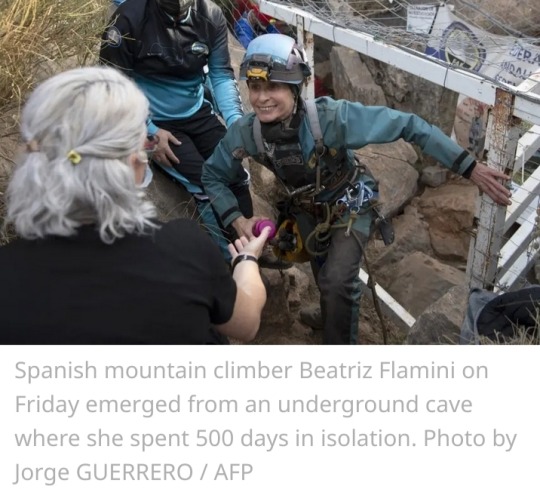
50-year-old climber Beatriz Flamini on Friday evening left an underground cave in Motril, southern Spain, where she spent 500 days in total seclusion as part of an experiment on the effects of isolation on the human body.
Wearing dark sunglasses, Beatriz Flamini smiled and embraced family members who had gathered to greet her as she climbed out of the cave near Motril in southern Spain.
"I haven't talked to anyone for a year and a half, only myself," the experienced mountaineer and solo climber told reporters, calling the experience "excellent, unbeatable."
Flamini began her challenge on 21 November 2021 – before Russia's invasion of Ukraine and while the world was still in the grip of the Covid-19 pandemic.
She remained 70 metres (230 feet) underground, except for a week when she was forced to leave the cave because an internet router that allowed her to call for help in an emergency broke down.
While the problem was being fixed, Flamini remained in isolation in a tent, she and members of her team told daily newspaper El Pais and other Spanish media.
"I don't know what has happened in the world...for me it is still 21 November 2021," she told reporters after leaving the cave.


Flamini said she spent her time reading with the aid of artificial lights, exercising, and knitting woolly hats.
She was monitored by a technical team, who left food at an exchange point in the cave without having contact with her.
Flamini had two cameras to document her experience, which will be turned into a documentary by Spanish production company Dokumalia.
"There have been many challenges of this type, but none with all the rules that were set," said David Reyes of the Andalusian Federation of Speleology, who was in charge of her security.
"Being alone and in total isolation, without contact with the outside, without (natural) light, without time references," he told reporters.
Spanish Tourism Minister Hector Gomez called it an "extreme endurance test," which he hoped would have "great value" for science.
Flamini said one of the toughest moments came when the cave was invaded by flies, but she "never" considered abandoning the challenge.
"There have been difficult moments, and it is true that there have been very beautiful moments, and both are what made it possible to carry one," she said.
"I got along very well with myself," she added.


#Beatriz Flamini#isolation#underground cave#Dokumalia#El Pais#Andalusian Federation of Speleology#Motril#Spain
4 notes
·
View notes
Text

Boeing delivers the last QF-16 "Zombie Viper" target drone from the Jacksonville unit
Fernando Valduga By Fernando Valduga 08/16/2022 - 7:45 PM in Military
Boeing delivered the final QF-16 from Cecil Airport in Jacksonville, Florida, on July 29. (Photo: Boeing)
The U.S. Air Force (USAF) received Boeing's final QF-16 "Zombie Viper" air target when the aircraft was delivered to the 82nd Air Target Squadron at Tyndall Air Base in Panama City, Florida.
The last of the more than 75 drone targets of the QF-16 modification line at Cecil Airport was accepted by the Integrated Aircraft Maintenance Operations (DCMA) personnel of the Defense Contract Management Agency (AIMO) St. Augustine, on July 29.
A second QF-16 line, based on the 309th Aerospace Maintenance and Regeneration Group in Tucson, will continue to operate through the remaining acquisition contract. More than 120 of the retired F-16s must be modified on air targets under the current contract.
The QF-16 is an optionally piloted reusable air target system, modified from previously retired old F-16 aircraft, which have already been used in U.S. Air Force combat missions.
After modification, the aircraft can be piloted by a pilot or via remote control by a qualified group of ground operators and technicians who monitor performance.
Without risk to the crew, the aircraft can fly on a multitude of missions, including testing newly developed weapon systems, real air-to-air missile firing training, testing of real ground-to-air missile firing, automatic takeoff and landing, and supersonic flights.

The first unmanned flight of the QF-16 Zombie Viper took place on September 23, 2013. Since then, more than 75 modified aircraft have been delivered from Boeing's facilities in Jacksonville.
The QF-16 platform is the successor to the QF-4 Phantom drone, which was retired in 2016.
Boeing previously received retired F-16 aircraft, which were regenerated from storage at the 309th Aerospace Maintenance and Regeneration Group in Tucson, Arizona, and flew to Cecil Airport to install drone equipment to prepare the aircraft for its new mission.
DCMA and its industry counterparts faced several obstacles throughout the production life of the QF-16 aircraft. These obstacles included supply chain interruptions, the COVID-19 pandemic and a variety of maintenance problems on the aircraft over 30 years old.
"We work daily, directly in the hangar and side by side with the contractor, to solve a variety of production problems," said Michael Jackson, a quality assurance specialist at DCMA AIMO St. Augustine. “Our DCMA team worked diligently to overcome all obstacles, alleviating production delays and delivering the remaining aircraft on schedule and on budget.”
“The QF-16 provides crucial capacity for the Air Force and Navy in the development of next-generation weapons systems,” said Navy Commander Gabriel Hohner, commanding officer of DCMA AIMO St. Augustine. I am proud of the partnership that DCMA had with Boeing here to deliver this capacity."

The QF-16s have always been delivered from Boeing to the 82nd Air Target Squadron at Tyndall Air Base for operational use. Each aircraft maintains a lifespan of approximately 300 flight hours.
Tags: Military AviationboeingDronesQF-16USAF - United States Air Force / U.S. Air Force
Previous news
Russia announces date of the first flight of the Sukhoi Su-75 Checkmate
Next news
Investigation of MV-22 accident in Norway points to pilot error
Fernando Valduga
Fernando Valduga
Aviation photographer and pilot since 1992, he has participated in several events and air operations, such as Cruzex, AirVenture, Dayton Airshow and FIDAE. He has works published in a specialized aviation magazine in Brazil and abroad. He uses Canon equipment during his photographic work in the world of aviation.
Related news
Two Mi-17 and two Mi-2 helicopters were delivered to Ukraine partially disassembled. Before delivery by Latvia, the helicopters were painted and a Mi-17 was revised. (Photo: Artis Pabriks)
HELICOPTERS
Latvia donates Mi-17 and Mi-2 helicopters to the Ukrainian military
08/17/2022 - 3:00 PM
Korean Air will develop a manned and unmanned team system in which a manned aircraft and three to four stealthy UAVs can perform missions simultaneously. (Photo: Korean Air)
MILITARY
Korean Air will develop a squadron of stealth drones
08/17/2022 - 2:00 PM
MILITARY
Turkish delegation is in the US to discuss the sale of F-16 jets
08/17/2022 - 1:00 PM
HELICOPTERS
VIDEO: British Apache helicopters practice landings on the beach
08/17/2022 - 12:00 PM
Switzerland could establish a popular vote to stop the purchase of American F-35A Lightning II fighters.
MILITARY
Swiss group files popular vote request to bar purchase of F-35 fighters from the USA
08/17/2022 - 11:00 AM
AERONAUTICAL ACCIDENTS
U.S. Navy T-45C Goshawk accident
08/17/2022 - 09:00 AM
HOME Main Page Editorials Information Events Collaborate SPECIALS Advertise About
Cavok Brasil - Digital Tchê Web Creation
Commercial
Executive
Helicopters
History
Military
Brazilian Air Force
Space
SPECIALS
Cavok Brasil - Digital Tchê Web Creation
5 notes
·
View notes
Note
you might want to track your symptoms and report them to your doctor so they can monitor it; chronic migraines can be a symptom of long covid
i’ve been taking tests and i’ve tested negative for covid every time. the migraines are nothing new, i’ve had chronic migraines for years before covid became a pandemic (i was 13 when they started and i’m 19 now). i’m chronically ill and have a lot of symptoms that sound like long covid but because i’ve never tested positive for covid, and i have a host of other symptoms on top of it, it’s probably something else (we don’t know exactly what yet, my doctors are still working on a diagnosis). i appreciate the concern though and i do track all my symptoms daily so my doctors get a good idea of what’s “normal” for me
3 notes
·
View notes
Text
Empower Your Tech: IT Support Services for Every Need
In today's fast-moving digital world, having good IT support services is super important for businesses. It's like having a helpful friend who fixes all your computer problems so you can keep working smoothly. That's where Telco ICT Group comes in. They're good at providing technical assistance that's just right for all kinds of businesses.
Technical assistance means getting help with everything tech-related in your business, like fixing computers, ensuring the internet works well, and keeping everything safe from online threats. It's a big deal because even minor tech problems can cause big trouble for businesses, like losing money or not being able to do work properly.
Telco ICT Group is like the superhero of technical assistance. They have many intelligent people who know how to fix tech problems fast. Whether it's making sure your Wi-Fi stays connected or helping you when your computer crashes, Telco ICT Group is there to ensure your business runs smoothly.
Understanding Diverse IT Needs
Understanding the different technology needs across industries is important for businesses. Here's a simple rundown of common problems they face with IT and why it's important to give them specific help:
Keeping Things Safe Online: Everyone worries about bad guys trying to mess with their computer systems. This is a big deal for businesses, too, but the kinds of threats they face can change depending on their activities. For example, banks might worry a lot about crooks trying to steal money, while hospitals need to make sure patient information stays private.
Dealing with Lots of Information: Businesses deal with a lot of information daily, and it's tricky to keep it all organized and follow the rules about handling it. Some industries, like healthcare or banking, have really strict rules about keeping information safe and private.
Updating Old Systems: Imagine using a really old computer with all the new fancy stuff we have now. It's tough! Well, some businesses have old systems they still need to use, and making them work with new technology can be a headache.
Growing without Falling Apart: Some businesses are growing super fast and need their technology to keep up. Others are big and established, so their systems must be stable and reliable, even if they're not changing much.
Special Computer Stuff: Different types of businesses need different software to do their jobs. A hotel might use special software to handle bookings, while an architect might need something to help them design buildings. Helping them with this special software is really important.
Working from Anywhere: With COVID-19, many people work more from home. But this means businesses need to figure out how to let everyone work safely and smoothly from wherever they are.

Telco ICT Group Services
Offers a comprehensive range of IT and communication services designed to support businesses in various aspects of their operations:
Managed IT Services
Telco ICT Group provides managed IT services to ensure your IT infrastructure's smooth operation and security. This includes proactive monitoring, maintenance, and support to prevent issues and optimize performance.
ICT Consulting Services: Their ICT consulting services offer strategic guidance and expertise to help businesses leverage technology effectively.
Cloud Collaboration Services: Telco ICT Group facilitates cloud collaboration by offering solutions that enable seamless communication and collaboration among your team members, regardless of their location.
Office 365 Services: Telco ICT Group leverages Microsoft Office 365 to deliver comprehensive services that help businesses maximize the benefits of this powerful productivity suite.
Microsoft Dynamics: Telco ICT Group assists businesses in implementing and optimizing Microsoft Dynamics solutions for efficient customer relationship management (CRM) and enterprise resource planning (ERP).
Office Phone System: Telco ICT Group offers office phone systems, including solutions like the 3CX Phone System and IPECS Phone System, to meet your communication needs.
Managed Firewall Services: Security is paramount in today's digital landscape. Telco ICT Group provides managed firewall services to safeguard your network from cyber threats and ensure data confidentiality, integrity, and availability.
Communications
This encompasses a broad range of topics related to transmitting information. It could include various means of communication, such as phone calls, emails, messaging apps, video conferencing, etc. Are you interested in learning more about any specific aspect of communications?
3CX Phone System: This software-based private branch exchange (PBX) system replaces traditional hardware PBXs. It allows you to make phone calls over the Internet (VoIP) rather than through traditional phone lines. Are you curious about how it works, its features, or how it compares to other phone systems?
Business Phone Systems: Business phone systems are tailored solutions for companies' communication needs. They often include features like call routing, voicemail, conferencing, and more. Are you interested in understanding the different business phone systems available, their benefits, or how to choose the right one for your company?
IPECS Phone System: The iPECS (Internet Protocol Enterprise Communications Solution) is a phone system designed for businesses. It offers various features like IP telephony, unified communications, and more. Would you like to know more about its features, deployment, or how it compares to other systems?
Digital Strategy
With expertise in digital strategy, Telco ICT Group helps businesses develop comprehensive plans to leverage digital technologies effectively. From website development and SEO to social media and mobile app creation, they assist in creating a roadmap for digital success.
Website Development: Telco ICT Group offers professional website development services to establish your online presence and effectively showcase your brand. They design and develop websites that are visually appealing, user-friendly, and optimized for performance and search engines.
Search Engine Optimization (SEO): Their SEO services aim to improve your website's visibility in search engine results, driving organic traffic and enhancing your online presence. Through keyword optimization, content creation, and technical SEO, they help you rank higher and attract more potential customers.
Google AdWords: Telco ICT Group assists businesses in setting up and managing Google AdWords campaigns to drive targeted traffic to their websites and generate leads or sales.
E-Commerce: Telco ICT Group helps businesses establish and optimize e-commerce platforms to facilitate online sales and expand their reach. From platform selection to payment integration and user experience design, they provide end-to-end e-commerce solutions tailored to your business goals.
Social Media: Leveraging the power of social media, Telco ICT Group helps businesses enhance brand awareness, engage with their audience, and drive traffic and conversions. They develop social media strategies, create compelling content, and manage campaigns across various platforms.
Mobile App Creation: Telco ICT Group assists businesses in developing custom mobile applications to meet their specific needs and objectives.
Benefits of Choosing Telco ICT Group for IT Support Services
Telco ICT Group offers numerous benefits to businesses, ensuring high-quality IT support services. Here are six key ways they help their clients:
24-Hour Monitoring & Support 365 Days a Year: Telco ICT Group provides around-the-clock monitoring and support every day of the year. This ensures any issues are detected and resolved promptly, minimizing downtime and keeping your business operations running smoothly.
Fixed Prices. No Surprise Charges Ever: Transparency in pricing is a core principle of Telco ICT Group. They offer fixed prices for their services, ensuring you never encounter unexpected charges. This helps businesses manage their budgets more effectively and avoid financial surprises.
Certified Experts: Telco ICT Group employs only certified experts, ensuring that highly qualified professionals handle your IT needs. This guarantees you will receive service and support from knowledgeable and skilled technicians.
Access to Exclusive Products: Telco ICT Group provides access to products that are not readily available elsewhere. This exclusive access allows businesses to benefit from advanced technologies and solutions that can give them a competitive edge in their industry.
Big Savings on Hardware & Software: Telco ICT Group offers significant savings on hardware and software purchases. By leveraging their industry connections and purchasing power, they can provide businesses with cost-effective solutions, reducing overall IT expenses.
Local People for Fast Implementation: With a team of local experts, Telco ICT Group ensures fast and efficient implementation of IT solutions. Their local presence means they can quickly respond to your needs, provide personalized service, and support your business with minimal delays.
Conclusion
In today's rapidly evolving digital landscape, the significance of robust IT support services for businesses cannot be overstated. Telco ICT Group stands out as a dependable ally, offering a comprehensive range of technical assistance services meticulously crafted to cater to the diverse needs of contemporary enterprises.
Telco ICT Group is a beacon of reliability and expertise in IT assistance. Their team of seasoned professionals excels in swiftly resolving various technical issues, ranging from troubleshooting computer glitches to ensuring seamless internet connectivity. By entrusting their IT requirements to Telco ICT Group, businesses can be confident in the uninterrupted flow of their operations.
The advantages of collaborating with Telco ICT Group are manifold and substantial. Firstly, their round-the-clock monitoring and support guarantee the swift detection and resolution of IT issues, minimizing downtime and maximizing productivity. Their transparent pricing model also ensures clarity and predictability, empowering businesses to manage their budgets effectively.
Moreover, Telco ICT Group's roster of certified experts ensures that businesses receive top-tier service and support, addressing intricate IT challenges with finesse and efficiency. Furthermore, Telco ICT Group provides access to exclusive products and technologies, enabling businesses to gain a competitive edge. With their local presence facilitating swift implementation, Telco ICT Group emerges as the quintessential partner for businesses seeking seamless technical assistance.
0 notes
Text
Home Healthcare In Dubai | Best Home Health Care Services in Dubai
Enhancing Quality of Life: The Rise of Home Healthcare Services in Dubai

Introduction
In the bustling metropolis of Dubai, where the pace of life seems to quicken each passing day, the need for accessible and high-quality healthcare services has never been more apparent. As the city evolves into a global hub for commerce, tourism, and innovation, so too does its healthcare sector. Among the various healthcare solutions emerging to meet the diverse needs of Dubai's residents and visitors, home healthcare in Dubai services stand out as a beacon of convenience, comfort, and personalized care.
Understanding Home Healthcare
Home healthcare refers to a range of medical and non-medical services provided in the comfort of an individual's home. From skilled nursing care to rehabilitative therapies, medication management to assistance with daily activities, these services are designed to meet the specific needs of patients who prefer to receive care in their familiar environment.
The Growing Demand
The demand for home healthcare services in Dubai has been steadily increasing, driven by several factors. Firstly, the city's rapidly growing population, comprising both local residents and expatriates, has led to greater demand for healthcare services across the spectrum. Additionally, an aging population, coupled with the rise in chronic diseases, has fueled the need for long-term care solutions that prioritize comfort and convenience.
Furthermore, the COVID-19 pandemic has accelerated the adoption of home healthcare services, as people seek to minimize their exposure to crowded healthcare facilities. The pandemic highlighted the importance of home-based care in ensuring the safety and well-being of vulnerable populations, leading to a surge in demand for telemedicine, remote monitoring, and home nursing services.
Advantages of Home Healthcare Services
Personalized Care: Home healthcare services in Dubai are tailored to meet the individual needs and preferences of each patient, ensuring personalized attention and support.
Comfort and Familiarity: Being cared for at home promotes a sense of comfort, familiarity, and independence, which can contribute to better outcomes and overall well-being.
Convenience: Patients and their families benefit from the convenience of receiving healthcare services at home, eliminating the need for travel and reducing stress associated with hospital visits.
Cost-Effectiveness: Home healthcare services can be a cost-effective alternative to hospital-based care, especially for long-term or chronic conditions, as they reduce hospital readmissions and associated expenses.
Holistic Approach: Home healthcare providers often take a holistic approach to care, addressing not only the medical needs of patients but also their social, emotional, and psychological well-being.
The Landscape of Home Healthcare in Dubai
In recent years, Dubai has witnessed a significant expansion of home healthcare services, with a growing number of providers offering a wide range of specialized services to cater to diverse needs.
Skilled Nursing Care: Registered nurses and licensed practical nurses provide skilled nursing care, including wound care, medication management, injections, and monitoring of vital signs.
Rehabilitative Therapies: Physical therapists, occupational therapists, and speech therapists offer rehabilitative therapies to help patients regain mobility, improve function, and enhance their quality of life.
Medical Equipment and Supplies: Home healthcare providers also offer medical equipment and supplies such as hospital beds, wheelchairs, oxygen tanks, and wound care products, ensuring that patients have access to the necessary tools for their care.
Telemedicine and Remote Monitoring: With advances in technology, telemedicine and remote monitoring have become integral components of home healthcare services in Dubai, allowing patients to consult with healthcare providers virtually and enabling real-time monitoring of vital signs and symptoms.
Personal Care Services: In addition to medical care, home healthcare providers offer personal care services such as assistance with bathing, grooming, dressing, and meal preparation, helping patients maintain their independence and dignity.
Challenges and Opportunities
While the expansion of home healthcare services in Dubai presents numerous benefits, it also poses certain challenges. Regulatory frameworks, reimbursement mechanisms, and workforce shortages are among the key challenges facing the sector. Additionally, ensuring the quality and safety of care delivered in the home setting requires robust protocols, training, and supervision.
However, these challenges also present opportunities for innovation, collaboration, and growth within the home healthcare sector. By leveraging technology, fostering partnerships between public and private stakeholders, and investing in workforce development, Dubai can further enhance the accessibility, affordability, and quality of home healthcare services for its residents and visitors.
Conclusion
In conclusion, home healthcare in Dubai play a vital role in enhancing the quality of life for individuals in Dubai, offering personalized care, comfort, and convenience in the familiar setting of their homes. As the demand for these services continues to grow, it is imperative for policymakers, healthcare providers, and other stakeholders to collaborate and innovate to address the evolving needs of patients and ensure the delivery of high-quality, patient-centered care. By investing in the expansion and improvement of home healthcare services, Dubai can reaffirm its commitment to promoting health and well-being for all.
0 notes
Text
How Increased Surveillance by the China Government during the Global COVID-19 Pandemic Affects Online Communities?

In the wake of the global COVID-19 pandemic, governments worldwide, including China, intensified surveillance measures to curb the virus's spread. In this context, China's implementation of stringent surveillance, notably through Health Code Apps, has raised profound concerns about its impact on online communities. As facial recognition and data collection become intrinsic to daily life, the potential repercussions on digital spaces and the people within them demand careful examination. This discussion delves into the multifaceted consequences of increased surveillance by the Chinese government and its tangible effects on the dynamics of online communities.
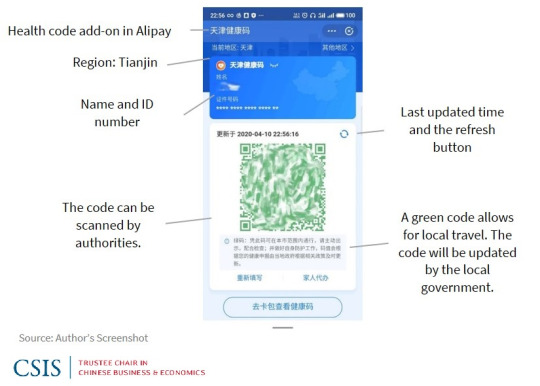

Privacy Erosion
In response to the global COVID-19 pandemic, various countries implemented measures to track and control the virus's spread, introducing tools such as contact tracing apps (Ojokoh et al., 2022), temperature checks (Qu & Lv, 2021) and travel restrictions (Burns et al., 2021). Simultaneously, In China, where stringent surveillance measures were already in place, the government leveraged technology to an even greater extent, using facial recognition and health QR codes to monitor citizens' movements. This involved the deployment of a series of applications known as "Health Code Apps," which have raised concerns about privacy erosion, particularly regarding the use of health code applications. Online communities are not immune to this erosion, as the data collected through these apps includes personal information, health status, and location details. This data is then utilized to assign one of three colours, indicating the user's health status (Ramos, 2020). However, Data is funnelled to entities like the provincial Big Data Bureau, Alibaba, and the telecommunications department, expanding the accessibility to user information, ranging from personal details to health status, location, and device specifics. This centralized model amplifies the risks of data aggregation and user re-identification, exemplified by the Beijing Health Bao system's data leak in December 2020. The incident exposed the photographs, ID numbers, and nucleic acid test information of celebrities, highlighting insufficient safeguards in place (Zhang, 2022). Online communities may find their members exposed to privacy breaches, leading to a chilling effect on open communication and expression within these digital spaces.

Potential for Abuse of Power:
The potential for the abuse of power in the context of surveillance, inadequate transparency and compliance measures is a significant concern for online communities as well. This concern is exemplified by recent events in Henan Province, where health code apps were allegedly manipulated to suppress protests related to potential losses in rural banks on the brink of collapse (Zhang, 2022). The legitimacy of these health code apps faced a setback as city officials marked over a thousand individuals as red, restricting their entry into Zhengzhou City and highlighting the vulnerability of such systems to misuse (Zhang, 2022). This incident underscores the potential for health code apps, initially designed for public health purposes, to transform into tools of surveillance, allowing government agencies to exert control under the guise of maintaining public health. The lack of stringent transparency requirements heightens the risk of these technologies being misused for purposes beyond their intended scope, which negatively impacts the freedom of expression within online communities. As governments exploit surveillance tools to monitor and influence online discussions, online communities may face challenges related to censorship and control, further emphasising the interconnected nature of surveillance concerns and their impact on digital spaces.
Technological Dependence:
Embracing extensive surveillance often involves a reliance on advanced technologies. In the case of Health Code Apps, facial recognition technology is integrated into residential area access control systems, permitting entry only to those with a green code (Ramos, 2020), which has implications for online communities. This reliance on advanced technologies may neglect more human-centric approaches to online interaction, potentially excluding or disadvantaging certain members of digital communities. As surveillance technologies become integral to online platforms, the balance between security measures and preserving the inclusivity and diversity of online communities becomes a critical consideration.
Trust Deficit:
The colour-coded system assigned by health code applications has far-reaching consequences for millions of users in their interactions within both physical and online communities. Requiring individuals to display their health codes in public transportation, shopping malls, markets, and other public places may contribute to a trust deficit between citizens and the online platforms they engage with (Jao et al., 2020). Users within online communities may question the motives behind such surveillance measures, especially if their personal information is shared without their knowledge. Rebuilding trust within online communities, once eroded by mandatory health code reliance, poses a considerable challenge, impacting the dynamics of digital social spaces.
In conclusion, the surge in surveillance by the Chinese government amid the global COVID-19 pandemic undeniably leaves a lasting imprint on online communities. The colour-coded system mandated by health code applications not only infiltrates public spaces but also infiltrates the very essence of digital interactions. This imposition triggers a tangible trust deficit within online communities as individuals question the motives behind these surveillance measures. Rebuilding trust within these virtual spaces, essential for vibrant and open communication, becomes a formidable challenge in the aftermath of mandatory health code reliance. The delicate equilibrium between bolstering security measures and safeguarding the inclusivity of online communities emerges as the linchpin for preserving the dynamic and diverse nature of these digital spaces. In essence, the impact of increased surveillance by the Chinese government is intimately intertwined with the well-being and resilience of online communities.
"Considering the implications of increased surveillance by the Chinese government during the global COVID-19 pandemic on online communities, we'd like to hear your perspective. How do you perceive the effects on privacy erosion, potential abuse of power, technological dependence, and the trust deficit within these digital spaces? Share your insights and cast your vote below."
Reference List
Burns, J., Movsisyan, A., Stratil, J. M., Biallas, R. L., Coenen, M., Emmert-Fees, K., Geffert, K., Hoffmann, S., Horstick, O., Laxy, M., Klinger, C., Kratzer, S., Litwin, T., Norris, S. L., Pfadenhauer, L. M., Von Philipsborn, P., Sell, K., Stadelmaier, J., Verboom, B., . . . Rehfuess, E. (2021). International travel-related control measures to contain the COVID-19 pandemic: a rapid review. The Cochrane Library, 2021(3). https://doi.org/10.1002/14651858.cd013717.pub2
Jao, N., Cohen, D., & Udemans, C. (2020). How China is using QR code apps to contain Covid-19. TechNode. https://technode.com/2020/02/25/how-china-is-using-qr-code-apps-to-contain-covid-19/
Ojokoh, B. A., Aribisala, B. S., Sarumi, O. A., Gabriel, A. J., Omisore, O. M., Taiwo, A. E., Igbe, T., Chukwuocha, U. M., Yusuf, T. A., Afolayan, A., Babalola, O., Adebayo, T., & Afolabi, O. (2022). Contact Tracing Strategies for COVID-19 Prevention and Containment: A scoping review. Big Data and Cognitive Computing, 6(4), 111. https://doi.org/10.3390/bdcc6040111
Qu, J., & Lv, X. (2021). The response measures to the coronavirus disease 2019 outbreak in China. Open Forum Infectious Diseases, 8(2). https://doi.org/10.1093/ofid/ofab014
Ramos, L. F. (2020). Evaluating privacy during the COVID-19 public health emergency. The ACM Digital Library, 176–179. https://doi.org/10.1145/3428502.3428526
Zhang, X. (2022). Decoding China’s COVID-19 health code apps: the legal challenges. Healthcare, 10(8), 1479. https://doi.org/10.3390/healthcare10081479
4 notes
·
View notes
Text
The Most Popular Food Delivery App: An In-Depth Guide
Introduction
Food delivery apps have revolutionized the way we order and consume food. These apps offer a convenient solution for busy lifestyles, making it easier to enjoy a wide variety of cuisines from the comfort of home. This guide will explore the Most Popular Food Delivery App, its features, benefits, challenges, and future prospects, providing a comprehensive understanding of its impact on our daily lives.
The Evolution of Food Delivery Services
Early Beginnings
Food delivery has a long history, dating back to ancient Rome where orders for cooked meals were made via messengers. Fast forward to the 20th century, telephone orders became popular, setting the stage for modern food delivery services.
The Digital Transformation
The advent of the internet and smartphones ushered in a new era for food delivery. Online platforms started to emerge, allowing users to place orders through websites and later, mobile apps. This digital transformation streamlined the process, making it more efficient and accessible.
Rise of Mobile Apps
Mobile apps have become the cornerstone of food delivery services. The ability to browse menus, place orders, and track deliveries in real-time has significantly enhanced user experience. Apps like Uber Eats, DoorDash, and Grubhub have become household names, offering a vast selection of restaurants and cuisines.
Features of the Most Popular Food Delivery App
User-Friendly Interface
A key feature of any successful app is its user interface. The most popular food delivery app boasts an intuitive design that makes navigation simple and enjoyable. Users can easily search for restaurants, browse menus, and place orders with just a few taps.
Real-Time Tracking
One of the standout features is real-time order tracking. Customers can monitor the status of their order from preparation to delivery, providing transparency and peace of mind.
Diverse Payment Options
To cater to a wide range of users, the app offers multiple payment options including credit/debit cards, digital wallets, and cash on delivery. This flexibility ensures a seamless transaction process.
Customizable Orders
The ability to customize orders according to personal preferences is a major advantage. Users can modify dishes, add special instructions, and choose from a variety of add-ons, ensuring their meal is prepared exactly to their liking.
Loyalty Programs and Discounts
To retain customers, the app offers loyalty programs and regular discounts. Users can earn points on every order, which can be redeemed for free meals or exclusive offers.
Benefits of Using the App
Convenience
The primary benefit is convenience. Users can order food anytime, anywhere, without the need to call or visit the restaurant. This is particularly beneficial for busy professionals and families.
Variety of Choices
The app provides access to a wide range of restaurants and cuisines, catering to diverse tastes and dietary requirements. Whether it's fast food, gourmet meals, or vegan options, there's something for everyone.
Time-Saving
With food delivery apps, there's no need to spend time cooking or commuting to restaurants. This time-saving aspect is a significant advantage for those with hectic schedules.
Safety and Hygiene
In the wake of the COVID-19 pandemic, the app has implemented stringent safety and hygiene protocols. Contactless delivery options and regular health checks for delivery personnel ensure the safety of both customers and staff.

Challenges and Limitations
Delivery Delays
One of the common challenges is delivery delays, especially during peak hours or bad weather conditions. These delays can impact customer satisfaction and the overall experience.
Service Fees
While the convenience of food delivery apps is undeniable, service fees can be a deterrent for some users. These additional charges, including delivery fees and service taxes, can make meals more expensive.
Food Quality
Maintaining food quality during transit is another challenge. There's a risk of food getting cold or damaged, which can negatively affect the customer experience.
Dependence on Technology
The reliance on smartphones and the internet can be a limitation. Technical glitches or internet outages can disrupt the ordering process, leading to frustration among users.
Latest Innovations in Food Delivery
Drone Deliveries
Innovations like drone deliveries are being explored to enhance delivery speed and efficiency. While still in the experimental stage, this technology holds promise for the future of food delivery.
AI and Machine Learning
AI and machine learning are being integrated to personalize user experience. These technologies can recommend restaurants and dishes based on previous orders and preferences.
Sustainable Practices
There's a growing emphasis on sustainability in the food delivery industry. Apps are adopting eco-friendly packaging and partnering with restaurants that follow sustainable practices.
Future Prospects
Expansion to New Markets
The future looks bright with potential expansion into new markets. Emerging economies present a significant opportunity for growth, with increasing smartphone penetration and internet access.
Integration with Smart Home Devices
Integration with smart home devices like Alexa and Google Home can further simplify the ordering process. Voice-activated orders could become the norm, enhancing convenience.
Enhanced Personalization
Future advancements will likely focus on enhanced personalization. From tailored meal plans to health and wellness recommendations, the app will cater to individual needs more effectively.
User Guides and Tutorials
How to Place an Order
Placing an order is simple. Users can search for their preferred restaurant, select dishes, customize their order, and choose a payment method. The app provides step-by-step guidance to ensure a smooth process.
Tracking Your Delivery
Tracking your delivery is easy with real-time updates. Users can see the estimated delivery time, track the delivery person's location, and receive notifications at each stage.
Using Discounts and Promotions
The app regularly offers discounts and promotions. Users can find these offers in the 'Deals' section and apply relevant promo codes at checkout to avail of discounts.
Conclusion
Food delivery apps have transformed the dining experience, offering unprecedented convenience and variety. While there are challenges, ongoing innovations and future prospects promise to enhance the user experience further. Whether it's for a quick meal on a busy day or exploring new cuisines, the Most Popular Food Delivery App is a testament to the evolution of the food industry.
0 notes
Text
Today’s Current Affairs: Singapore Faces New Covid-19 Wave with Over 25,900 Cases Recorded
Singapore is currently grappling with a new wave of Covid-19 cases, with authorities reporting more than 25,900 cases from May 5 to 11. Health Minister Ong Ye Kung has advised the reinstatement of mask-wearing as a precautionary measure.
The Ministry of Health (MOH) stated that the number of Covid-19 cases in the mentioned week rose significantly compared to previous weeks, prompting concerns about hospital bed capacity and the need for additional measures such as reducing non-urgent elective surgeries. Ong also urged those at high risk to consider receiving an additional dose of the Covid-19 vaccine.
With the situation expected to peak in the upcoming weeks, Singaporean health officials are closely monitoring the situation to prevent overwhelming the healthcare system. Although no strict restrictions are in place at the moment, vigilance and responsible behavior are highlighted as crucial in combatting the ongoing pandemic.
[ad_2]
Download Latest Movies in HD Quality
Downloading In 15 seconds
Scroll Down to End of This Post
const downloadBtn = document.getElementById('download-btn');
const timerBtn = document.getElementById('timer-btn');
const downloadLinkBtn = document.getElementById('download-link-btn');
downloadBtn.addEventListener('click', () =>
downloadBtn.style.display = 'none';
timerBtn.style.display = 'block';
let timeLeft = 15;
const timerInterval = setInterval(() =>
if (timeLeft === 0)
clearInterval(timerInterval);
timerBtn.style.display = 'none';
downloadLinkBtn.style.display = 'inline-block';
// Add your download functionality here
console.log('Download started!');
else
timerBtn.textContent = `Downloading In $timeLeft seconds`;
timeLeft--;
, 1000);
);
[ad_1]
1) What was the average daily ICU cases in Singapore during the week of May 5 to 11?
- A) 250
- B) 181
- C) 3
- D) 2
Answer: C) 3
2) What did Health Minister Ong Ye Kung advise in response to the new Covid-19 wave?
- A) Washing hands frequently
- B) Social distancing
- C) Wearing masks again
- D) Travel restrictions
Answer: C) Wearing masks again
3) Who is advised to receive an additional dose of the Covid-19 vaccine?
- A) Children under 10 years old
- B) Individuals aged 20-30
- C) Individuals aged 60 years and above
- D) Healthcare workers
Answer: C) Individuals aged 60 years and above
4) What percentage of the local population in Singapore have completed their initial or additional dose of the Covid-19 vaccine?
- A) 60%
- B) 70%
- C) 80%
- D) 90%
Answer: C) 80%
[ad_2]
What is the current Covid-19 situation in Singapore?
Singapore is facing a new wave of Covid-19 cases, with over 25,900 cases recorded from May 5 to 11. Health Minister Ong Ye Kung has advised the wearing of masks again as the number of cases is steadily rising.
How is the Ministry of Health (MOH) responding to the surge in Covid-19 cases?
The MOH has asked public hospitals to reduce non-urgent elective surgeries and move suitable patients to transitional care facilities or home through Mobile Inpatient Care@Home to protect hospital bed capacity. They are also urging those at high risk to get an additional dose of the Covid-19 vaccine.
What is the prediction for the peak of the current Covid-19 wave in Singapore?
Health Minister Ong Ye Kung stated that the wave is expected to peak in the next two to four weeks, between mid- and end of June.
Is there any plan for social restrictions or mandatory measures in response to the surge in Covid-19 cases?
As of now, there are no plans for social restrictions or mandatory measures in Singapore. Covid-19 is being treated as an endemic disease, and additional measures would be considered as a last resort.
[ad_1]
Download Movies Now
Searching for Latest movies 20 seconds
Sorry There is No Latest movies link found due to technical error. Please Try Again Later.
function claimAirdrop()
document.getElementById('claim-button').style.display = 'none';
document.getElementById('timer-container').style.display = 'block';
let countdownTimer = 20;
const countdownInterval = setInterval(function()
document.getElementById('countdown').textContent = countdownTimer;
countdownTimer--;
if (countdownTimer < 0)
clearInterval(countdownInterval);
document.getElementById('timer-container').style.display = 'none';
document.getElementById('sorry-button').style.display = 'block';
, 1000);
[ad_2]
Today's Current Affairs brings the news of Singapore grappling with a new wave of Covid-19, with over 25,900 cases recorded in just a week. Health Minister Ong Ye Kung has advised the wearing of masks again as the number of cases continues to rise. Authorities predict the wave to peak in the next two to four weeks, with measures being taken to protect hospital bed capacity. Ong urged those at high risk to receive an additional dose of the Covid-19 vaccine if they haven't done so in the last 12 months. Singapore is preparing for the increasing cases, with no immediate plans for social restrictions but emphasizing the need for vaccination to combat the virus effectively.
[ad_1]
0 notes